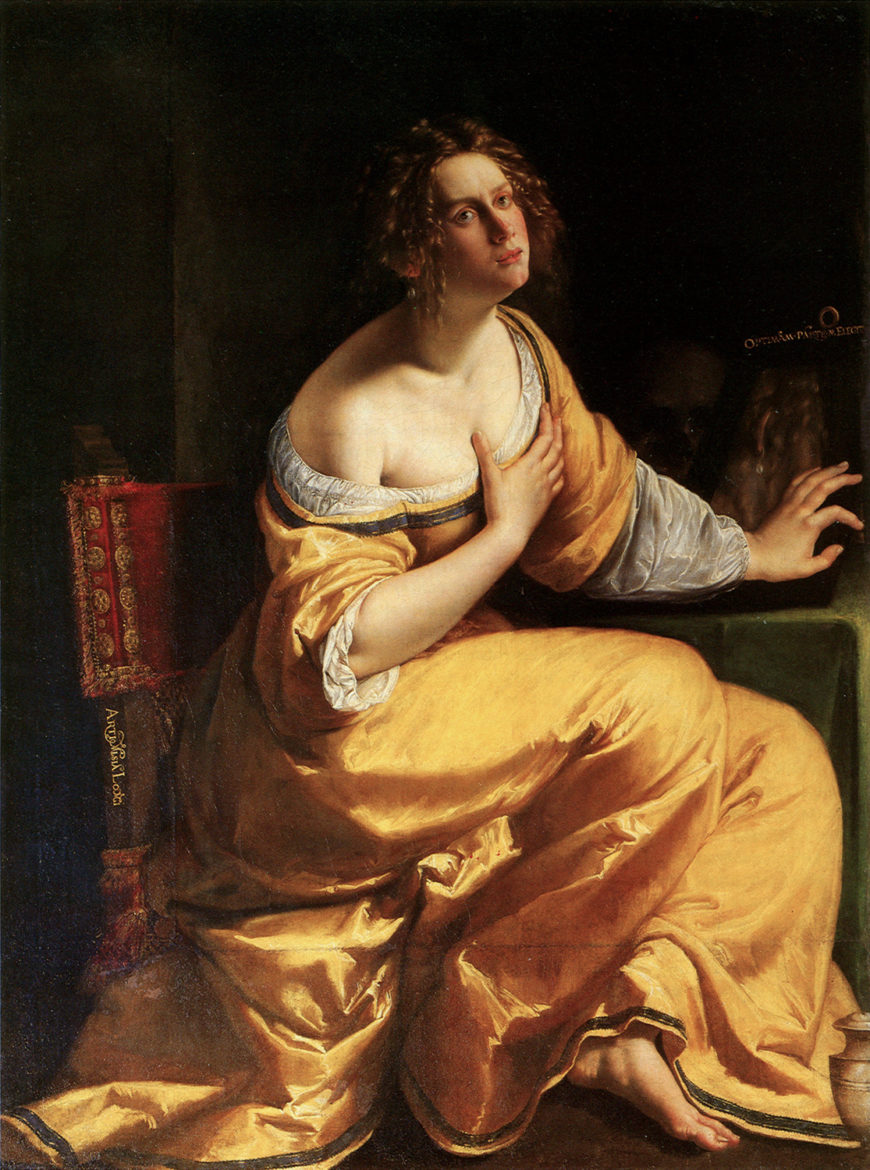
Artemisia Gentileschi, Penitent Magdalene, c. 1615–16, oil on canvas, 146.5 × 108 cm (Palazzo Pitti, Uffizi, Florence)
Dressed in luxurious yellow satin, her head crowned with blonde ringlets, a young woman clutches her breast and gazes upward overcome with emotion. Her dress almost obscures the chair she sits on, and behind her to the right is a small table with a mirror on it. The painting’s subject would have been instantly recognizable to anyone in 17th-century Europe as a representation of the penitent Mary Magdalene turning away from a life of sin to become one of Jesus’ followers. In the mirror on the table beside her, we see the reflection of her neck, golden locks, and precious pearl earring. This tells us she has been reflecting on her past life of sin and luxury, and is now ready to reject it and embrace a life of Christian virtue. But the treatment of the subject was unusual for its striking naturalism and for the lavish treatment of the shimmering surface of the painting. Even more unusual is the fact that—as the elaborate golden signature along the side of the chair advertises—this work was painted by a woman: the Italian baroque artist Artemisia Gentileschi.
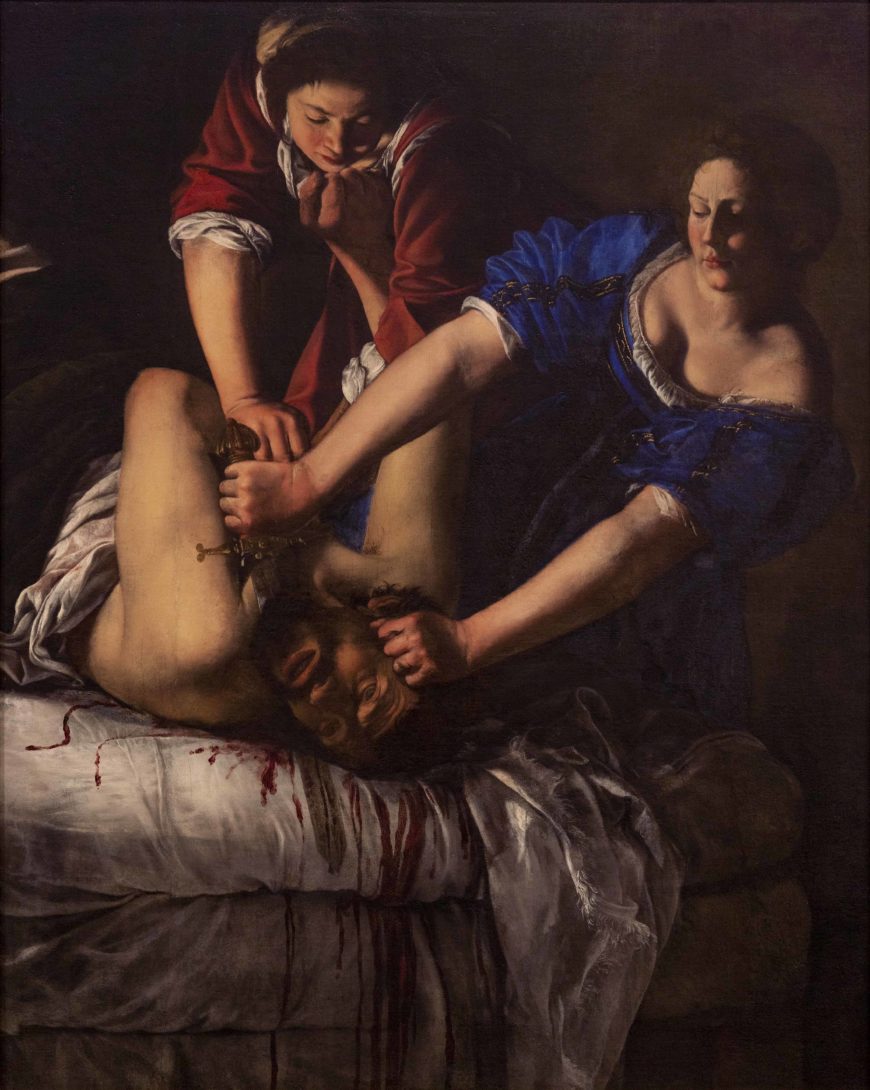
Artemisia Gentileschi, Judith beheading Holofernes, 1611–12, oil on canvas, 159 x 126 cm (Museo Nazionale di Capodimonte, Naples; photo: Steven Zucker, CC BY-NC-SA 2.0)
A successful painter
Along with Sofonisba Anguissola and Lavinia Fontana, Artemisia Gentileschi was among the most successful female painters in early modern Italy. Women were not allowed to join artists’ workshops or academies, and so Artemisia was trained by her father, the painter Orazio Gentileschi. Orazio was friends with the painter Caravaggio and introduced his daughter to Caravaggio’s revolutionary approach, which rejected the longstanding artistic tradition of imitating imitating artists of the High Renaissance (such as Raphael or Michelangelo) and copying ancient Greek and Roman statues. Instead, it entailed hiring models, placing them in a room with a lantern or high window to create striking contrasts of light and dark, and painting them directly from life. Artemisia mastered this approach in her shockingly gory Judith beheading Holofernes (1611–12) which portrays the biblical heroine Judith and her maidservant decapitating the Assyrian general Holofernes. Painted painstakingly from life, the scene is illuminated starkly from the left, throwing the gruesome event into high relief. While this working method could create dramatic and life-like images, it also had its limitations in that it was a laborious process that required hiring models, and was thus expensive, and was most successful when painting still subjects that could be staged indoors. For women artists, these issues could be even more challenging as they were not allowed to attend the male-dominated academies and life-drawing studios.
A fashionably attired Magdalene
Artemisia’s style began to change when she left her native Rome in late 1612 or early 1613 to establish herself as an independent professional painter in Florence. In Florence, she was exposed to the work of local artists such as Cristofano Allori and Il Cigoli whose success inspired her to modify and temper the Caravaggism of her early years. We see these factors at play in Artemisia’s Penitent Magdalene, which was probably painted 1615–16, that is, around two years after her arrival in Florence.
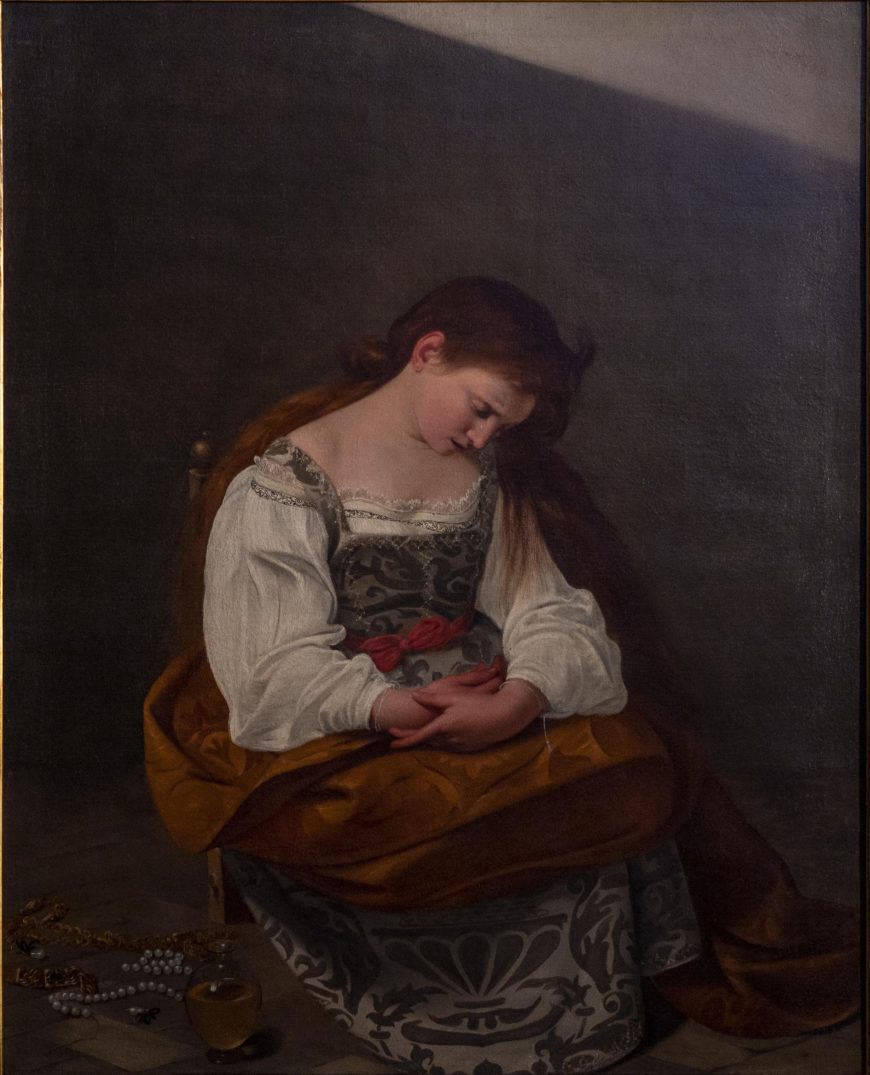
Caravaggio, Penitent Magdalene, 1597, oil on canvas, 122.5 x 98.5 cm (Doria Pamphilj Gallery, Rome; photo: Steven Zucker, CC BY-NC-SA 2.0)
The model that would have been most familiar to Artemisia was Caravaggio’s Penitent Magdalene. Caravaggio’s version shows Mary Magdalene as a young woman sitting in a nearly bare room, her head bowed and hands clasped in a gesture of melancholy and penitence, her vanities—pearls, jewels, and a bottle of ointment at her feet—indicating she has cast them aside. In contrast to Caravaggio’s austere young Magdalene, Artemisia’s Magdalene is fashionably attired in pearls, an elegant coiffure, and yellow satin. The dress in particular is a tour-de-force of painting shimmering surfaces and the nuances of how light and shadow interact and reflect off satin. The painting seems, paradoxically, to embrace the very luxury it denounces. What explains this contradiction?
One explanation is patronage. It is thought the painting was commissioned by, or at least intended for, Maria Maddalena of Austria, the Grand Duchess of Tuscany, whose name saint was Mary Magdalene (Maria Maddalena in Italian). She was known for her lavish tastes, and her involvement could explain the sumptuous tone of the painting. The prominent gold signature, full of elaborate flourishes, would also suggest that the artist was hoping to attract the attention of potential patrons in the Florentine court. Indeed, the artist signed her name ARTIMISIA LOMI using her familial name Lomi, which would have been familiar to Florentines, who might have known the art of her grandfather Baccio Lomi or uncle Aurelio Lomi, but unknown in Rome.

Mirror and skull (detail), Artemisia Gentileschi, Penitent Magdalene, c.1616, oil on canvas, 146.5 × 108 cm (57 9/16 × 42 1/2 in), (Palazzo Pitti, Uffizi, Florence)
A rejection of worldly vanities
But the tension between luxury and austerity is also part of the painting’s message. Above the mirror is inscribed OPTIMAM PARTEM ELEGIT, which means “She chose the better part.” The line refers to a passage in the New Testament (Luke 10:41–42), when Christ visited the home of the sisters Martha and Mary (not Mary Magdalene, but conflated with her in the western Christian tradition). While Martha did all the work of preparing for the meal, Mary instead sat at his feet and listened to his teaching. When Martha complained that Mary hadn’t helped at all, Jesus reprimanded her saying that, “Martha, Martha, you are anxious and upset about many things, when only one thing is necessary. Mary has chosen the better part, and it will not be taken away from her.” In other words, Mary chose the path of spiritual learning that offers eternal reward, while Martha chose to focus on worldly concerns.
These ideas were common in Artemisia’s day, as the same text appears prominently in a lavish painting by Florentine painter Alessandro Allori (whose son, Cristofano, was close friends with Artemisia) in which Mary is shown kneeling at Christ’s feet, absorbed in his teachings while Martha stands, carrying a tray of glassware.
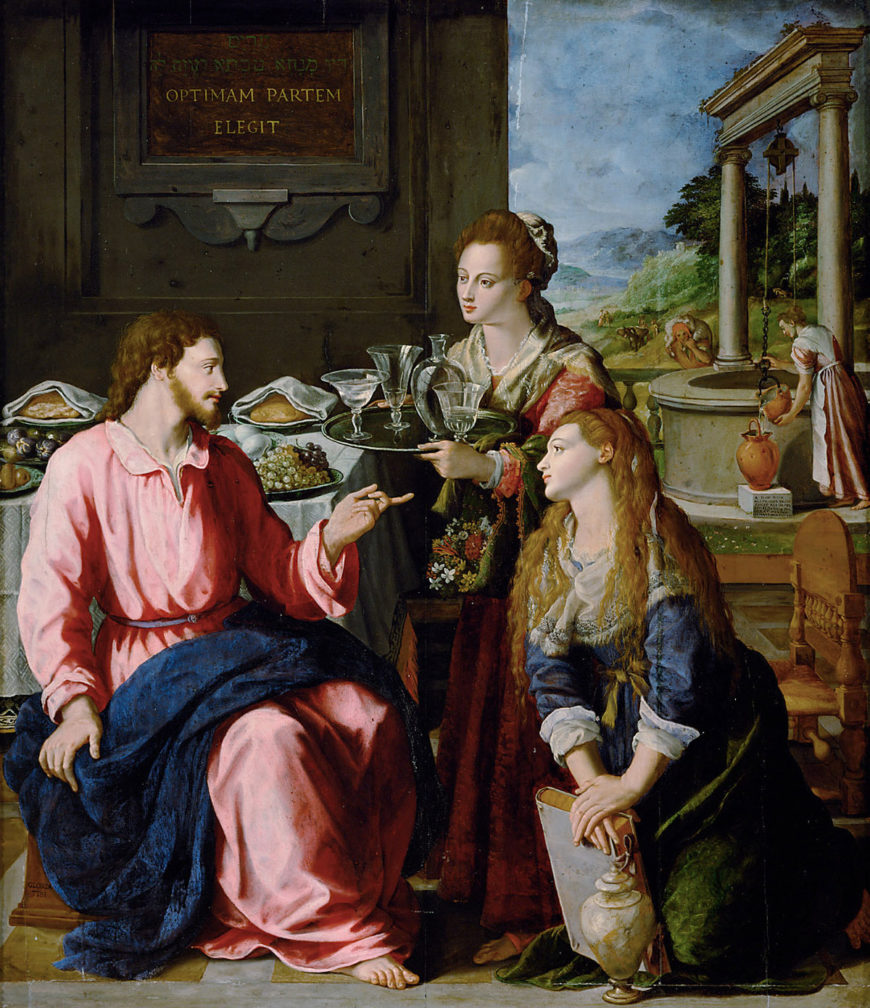
Alessandro Allori, Christ at the House of Martha and Mary, 1605, oil on poplar wood, 125 × 118 cm (Kunsthistorisches Museum, Vienna)
The notion of choosing between a spiritual and worldly path is implicit in Artemisia’s Penitent Magdalene in other ways, and the viewer is invited to consider and emulate Mary Magdalene’s rejection of worldly vanities to focus on divine salvation. Just below the inscription, to the left, and barely visible in the darkness at first glance, lurks a skull. This is a traditional reminder that, given the inevitability of death, all worldly pursuits are in vain and that we must, like Mary Magdalene, reject them and focus instead on spiritual matters.
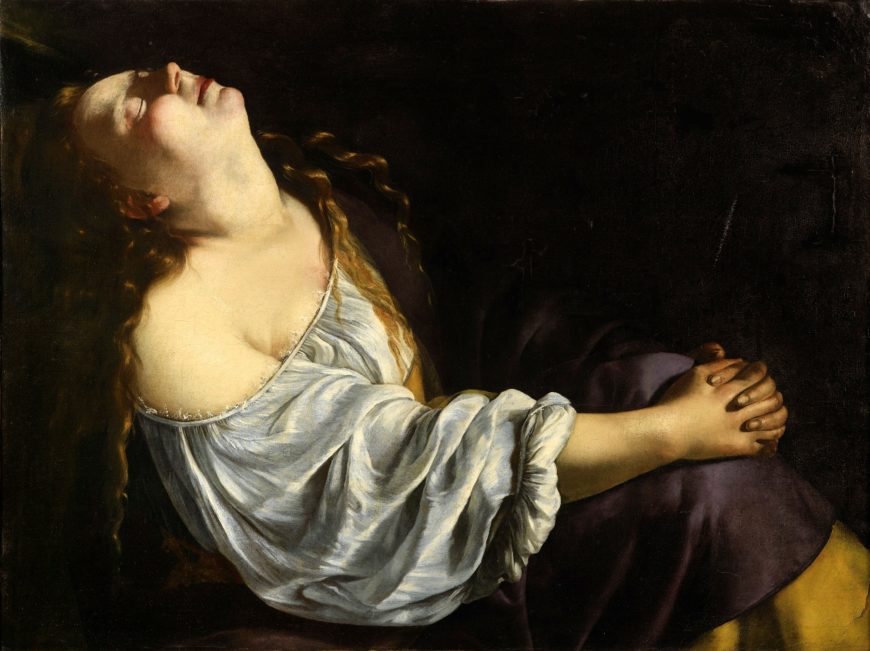
Artemisia Gentileschi, Mary Magdalene in Ecstasy, c.1623–5, oil on canvas, 81 × 105 cm (private collection)
The Penitent Magdalene shows to us the canny way in which Artemisia could adapt her style and subject matter according to the perceived tastes and interest of her audience. Indeed, in another version of the same subject, probably painted in Rome c. 1623–25 for an unknown patron, the artist has returned to a far more austere treatment of the subject, devoid of satin, jewels, or any other props. Instead, it focuses on the saint’s interior emotions, her eyes closed and face illuminated, as she contemplates whether to choose ” the better part. “
Additional resources
Artemisia at the National Gallery (Google Arts and Culture)
Orazio and Artemisia Gentileschi. Ed. Christiansen, Keith, and Judith W. Mann, New York, Metropolitan Museum of Art, 2001 (Online catalog of 2001 Met exhibition)
Barker, Sheila, ed. Lives of Artemisia Gentileschi. Lives of the Artists. London: Los Angeles: Pallas Athene; J. Paul Getty Museum, 2021.
Garrard, Mary D. Artemisia Gentileschi and Feminism in Early Modern Europe. Renaissance Lives. London, UK: Reaktion Books, 2020.
Locker, Jesse. Artemisia Gentileschi: The Language of Painting. New Haven and London: Yale University Press, 2015.

